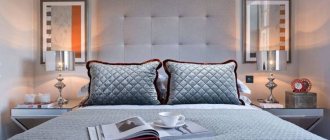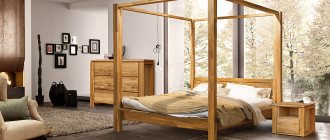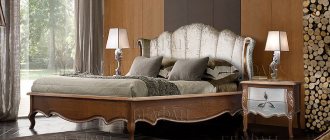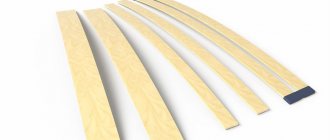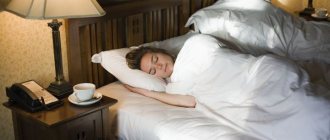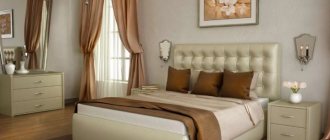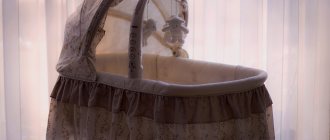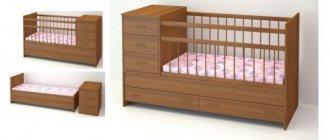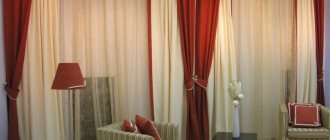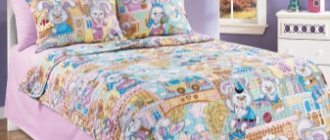The bedroom is not just a room in the apartment, but a special space for which the right atmosphere is a guarantee of comfortable rest and relaxation.
Therefore, we always approach the design of a bedroom with special attention, so that if not to turn your bedroom into a real corner of paradise, then at least to emphasize your taste. And the bedspread plays a significant role in the design of the bedroom interior. We will tell you how to choose it correctly and what to consider.
So, the most important nuances when choosing a bedspread and combining it with the interior:
- Combination with interior color. One solution is to fit your bedspread into the overall palette of shades in the bedroom. A good idea for small room sizes, where there is absolutely no need to emphasize the bed with contrast. For example, you can choose a turquoise bedspread in a blue bedroom or a white bedspread in a beige one. Don't forget that warm shades are preferable for the bedroom - they add coziness. A cold palette will come in handy in a hot room with windows facing south. For a large room, the bedspread can be used as a color accent.
- Combination with curtain color. Usually a bedspread and curtains are matched to the bedroom, like a handbag with shoes - in one color. This combination is considered a sign of good taste and style. True, today this approach is considered outdated and too conservative. However, you shouldn’t completely abandon the idea of this unity: you can combine with the curtain pattern, for example, pillows on the bed or a bedspread “skirt” that covers the legs of the bed. You can also add a bright accent to sofa cushions and curtain ties.
- Combination with decor. Another stylistic move is to continue the idea of decor in the bedspread, an accent wall above the bed or the head of the bed. That is, to achieve unity in the bedspread and bedside background. Naturally, there is no need to achieve 100% similarity - it is too boring for the overall interior. The color of the bedspread should differ by at least 2-3 tones from the decor, wallpaper, curtains. As a guide in decor, you can choose a furniture set or other important interior items that are the focus of your bedroom.
- Combination with bed design. If the bed is made in a modern style, then the royal bedspread “a la baroque” will look ridiculous on it.
Blue, light blue, turquoise
Shades of water perfectly support the calm character of the room. Deep blue looks surprisingly stylish, but is not recommended by Feng Shui rules for the bedroom.
A delicate blue shade will become universal. For a more daring design, an interesting turquoise color is suitable. A modern interior will only benefit from such an addition.
What color and pattern of the bedspread should I choose?
Most designers agree that the ideal bedspread is a bedspread without a pattern or with an unobtrusive light pattern. Patterned ones will come in handy in a children’s room, and too bright ones will be used as an accent.
If you like variety, look for a double-sided bedspread - you can change the pattern according to your mood.
- Stripes on the bedspread will expand the bed if the pattern is horizontal. As for the vertical stripes, they draw the eye to the wall above the headboard.
- The combination of curtains and bedspreads allows you to reduce the degree of “tension” in an overly bright interior by choosing calm shades or, on the contrary, splashing a little riot of colors on boring surfaces. A simple change of bedspread and curtains can sometimes change a room beyond recognition. Especially the small one.
- By choosing beige, sand and cream bedspreads , you get the opportunity to expand the range of color and stylistic solutions in the interior (these colors can be combined with almost any shade).
- If you are prone to melancholy or depression, look for warmer shades of bedspreads . If your bedroom is both an office and a living room where you need to concentrate on work, choose yellow and orange shades of bedspreads that awaken and inspire optimism. If you are hiding from the “hard world” in the bedroom and just want to relieve stress and get some sleep, choose shades of soothing green. But golden threads will add to your festive atmosphere.
Red, orange, yellow
Bright colors are often given the role of accents. Variations look great against a calm background. Red will add spice, orange will energize you, and yellow will give you a positive mood.
If excessive brightness is confusing, then it is permissible to prefer more moderate tones.
Choosing the right bedspread size for the bedroom - important measurements and nuances
The bedspread has 2 main purposes:
- Ensure that the shared sleeping area is tidy and protect the bed from dirt.
- Be part of the design solution.
But if absolutely any textile (and not only) can cope with the first task, only not every bedspread can solve interior tasks.
And you need to achieve harmony in everything, including the size of the bedspread, which in this particular case still matters.
Using a stitch
The characteristic appearance of such a product cannot be confused with anything else. A double “case” is made with a thin synthetic padding layer inside.
A network of stitches is laid on top. The seams serve a decorative function. The bedspread can simultaneously serve as a light blanket.
What size bedspreads do we know?
- 110 x 140 cm Children's version. Used for a small crib or as a play mat.
- 140 x 220 cm “One and a half” size is good for a teenage bed.
- 170 x 210 cm and 180 x 220 cm Option for a double bed, the legs of which do not need to be covered with a blanket.
- 200 x 220 cm There are many worthy options available today in the “euro” size. In addition, Euro-maxi sizes (220x240, 240x260 and 250x270) are also in great demand.
- 270 x 270 cm The maximum size that will be ideal for a large custom-made bed.
How to make a choice, and what size do you need?
Size selection rules:
- The optimal bedspread allowance is about 20-30 cm in the absence of bed restrictions in the form of a backrest and walls. This size is enough to protect the bed from dirt.
- If there are two backs, allowances are needed only for the width of the bedspread.
- If you have children and animals who constantly crumple the bedspread, it is better to choose an option with an elastic band that is fixed around the perimeter. This size is chosen in accordance with the dimensions of the bed.
- If you want to hide the bed legs, add another 60 cm to the standard size of the bedspread.
- It is not recommended to choose massive and wide bedspreads for beds with wide frames. Instead of a stylish part of the interior, you will get a ridiculous hut in the room.
- For a bed of a non-standard shape, the bedspread must be sewn to order.
How to care for a bedspread?
Caring for a bedspread primarily depends on the material.
Microfiber is easy to wash, does not deform and does not fade. However, the water temperature should not exceed 60 degrees. Drying the product in bright sun is not recommended.
In general, it is better not to wet faux fur, but to clean it with special chemical compounds. But it should be ventilated more often. First of all, natural silk must be very protected from contamination, and if trouble does happen, trust the solution to the problem to professionals.
Acrylic is easy to care for; if it is heavily soiled, it can be dry-cleaned, and slightly refreshed in a regular machine, choosing a delicate mode, or by hand washing. You just shouldn’t be overzealous with the spin, so as not to cause deformation. When rinsing, it is recommended to add conditioner, otherwise acrylic begins to lose its original softness over time. The fabric does not like high temperatures, so iron the bedspread with the iron control set to minimum and through a layer of gauze.
Washing fleece or bamboo bedspreads does not cause any problems at all. It is enough to soak the product in warm water with some not too aggressive detergent for half an hour, and then rinse well with the addition of conditioner. You can squeeze it in a machine, the main thing is not to dry it near fire sources or on a hot radiator.
Products made from viscose are washed by hand or on a delicate cycle, twisted at low speeds, and ironed at a minimum temperature. Considering the likely shrinkage after the first treatment, it is better to purchase a slightly larger bedspread in advance, “with a margin.”
Everything is complicated with a tapestry: they don’t recommend washing it in a machine, but it’s very difficult to wash it by hand. If stains accidentally appear, they must first be removed, and only then the entire product must be refreshed. The best option is periodic dry cleaning and regular airing in the open air.
Cotton bedspreads can be machine washed, but be careful when twisting them. It is better to dry naturally, in the air, remove slightly damp. If the product is over-dried, it will be very difficult to restore its original attractiveness - smoothing out “wrinkles” on cotton is extremely problematic.
Wool bedspreads may have different features, resulting in differences in care. First of all, you need to study the symbols on the label. If washing is allowed in principle, let it be done by hand or in a special mode in a machine, only in lukewarm or cool water (not higher than 30 degrees), with the addition of softening agents. It is not advisable to squeeze. Such a thing cannot be dried in a machine or in a suspended state - only laid out on a horizontal plane. Ironing a wool blanket is also prohibited.
What do you need to know?
- The bedspread is the first thing a person looks at when entering the bedroom. Therefore, the bedspread, first of all, should be present, and secondly, it should not stand out from the general style.
- If natural materials dominate in the bedroom, choose a bedspread made from the same ones - linen, cotton, wool or even silk.
- If the interior is oversaturated with materials such as laminate, polyresin, plexiglass/glass, etc. , look for an option made from mixed fabrics.
Video: 76 bedspread ideas
Focus on the style of the bedroom. It is unlikely that a modern black and white “minimalist” bedspread will look harmonious in a luxuriously ornate bedroom with canopies, candelabra and monograms in the stucco ceiling.
- For a royal bedroom, a bedspread with a heavy texture, rich drapery and golden shades is more suitable.
- In a minimalist style bedroom, the bedspread should be chosen with or without a simple ornament, made of light fabric, without ruffles or other elements.
- A patchwork bedspread will come in handy in a rustic bedroom.
- For country, boho, Provence - floral patterns, linen, quilted cotton and patchwork technique.
- For modernism - satin bedspreads with frills and ruffles.
- Ethnic style implies an appropriate pattern (giraffe, zebra or jaguar colors).
- For loft and contemporary we choose laconic options made of wool or satin.
- High-tech style requires geometric prints, smooth surfaces and any non-standard elements.
- A knitted bedspread is an excellent modern solution (especially large knitted bedspreads). Disadvantage: it quickly wears out, becomes deformed, and breaks.
Which bedspread did you choose? What were you guided by in your choice?
Share your secrets of choosing bedspreads for the bedroom with our readers!
Material
Since the main purpose of the bedspread comes down to decorative and protective functions, any fabric can be used for it. The main thing is that it can withstand frequent washing, not wrinkle, and retain its attractive appearance for a long time.
This is true for studio apartments, where the bed is constantly in sight. The bedspread helps hide bed linen from prying eyes and compensates for minor flaws if you made the bed in a hurry.
If outsiders are prohibited from entering your bedroom, then the bedspread can easily combine the functions of a rug and a blanket. In this case, it is better to give preference to natural fabrics that easily absorb moisture and allow the body to breathe.
To reconcile aesthetic and practical aspects, designers often use two-layer models, in which the back is made of cotton or wool, and the front is made of synthetic fibers that do not wrinkle and are easy to clean.
So, what list of fabrics and materials do modern designers offer?
- Cotton . Great for double-sided and summer models.
- Linen . An ideal solution for rooms in eco-style, as well as in interiors decorated in the spirit of Provence, Country, etc.
- Wool is characteristic of Scandinavian motifs.
- Fur is good for the same Scandinavia, Chalet, eclecticism.
- Artificial fiber fits perfectly into modern interiors in the spirit of modern, high-tech, loft and urban.

